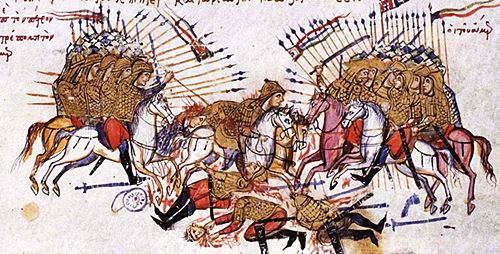
Battle of Poson(Battle of Lalakaon or of Proson) |
year: 8633 September 863 |
| Decisive victory of the Byzantines against the Arabs of Melitene | ★ ★ ★ ★ ★ |
|
enemy: Arabs (of Melitene)
|
location: At a location called Poson (Greek: Πόσων) or Porson near the Lalakaon river The exact location of the river and the battle site have not been identified; most scholars, agree that they lay near the river Halys, 130 km southeast of Amisos
|
accuracy:
●●●●●
|
|
battle type: Pitched Battle |
war: Byzantine-Muslim Wars |
modern country:
Turkey |
| ▼ The Byzantines(emperor: Michael III the Drunkard) | ▼ The Enemies | |
| Commander: | Patrician Petronas | Emir Omar al-Aqta |
| Forces: | Unknown | Unknown |
| Losses: |
| Background story: |
| After the storm Muslim conquests of the 7th century, the Byzantine Empire found itself confined to Asia Minor. Arab raids continued into Asia Minor throughout the 8th and 9th centuries. Byzantium was generally on the defensive, suffering sometimes catastrophic defeats. After 842 and the rise of semi-independent emirates beyond the Byzantine eastern frontier, the Byzantines were increasingly able to assert their own power. In the 850s, the most persistent threats to the Empire were the emirate of Malatya (Melitene), the emirate of Tarsus, the emirate of Qaliqala (Greek: Theodosiopolis, modern Erzurum) and the Paulicians of Tephrike. Melitene, in particular, was a major threat. In the summer of 863, Omar struck again, uniting his forces with those of Tarsus for a raid into Cappadocia, and it is likely that a Paulician contingent under Karbeas was present as well. The Arabs reached as far as Tyana, but there, for unknown reasons, the larger army of Tarsus turned back, while the emir of Melitene decided to press on alone. Emperor Michael III had assembled an army to counter the Arab raid, and met them at a battle in an area called Marj al-Usquf ("Bishop's Meadow") by Arab sources, a highland near Malakopea, north of Nazianzus. The battle was bloody with many casualties on both sides; nevertheless, the Arabs managed to evade the Byzantines and continue their raid north into the Armeniac Thema, eventually reaching the Black Sea and sacking the port city of Amisos (Samsun). As soon as Michael learned of the fall of Amisos, he ordered a huge force to be assembled under his uncle Petronas. The forces assembled came from all over the Empire. Three separate armies were formed which converged upon the invading Arabs. |
The Battle: |
 The battle of Lalakaon in the Skylitzes manuscript With the approach of the Byzantine armies, the only open escape route left to the emir and his men was dominated by a strategically located hill. During the night, both Arabs and Byzantines tried to occupy it, but the Byzantines emerged victorious from the ensuing fight. On the next day, 3 September, Omar decided to throw his entire force towards the west, where Petronas was located, in hopes of achieving a breakthrough. The Byzantines, however, stood firm, giving the other two Byzantine wings the time to close in and attack the Arab army's exposed rear and flanks. The rout was complete, as the larger part of the Arab army and Omar himself fell on the field. Casualties also possibly included the Paulician leader Karbeas. Only the emir's son, at the head of a small force, managed to escape the battlefield, fleeing south towards the border area of Charsianon. He was, however, pursued by Machairas, the kleisourarches of Charsianon, and was defeated and captured with many of his men. Petronas returned to Constantinople in triumph. |
Noteworthy: |
| The victory inspired the creation of one the oldest surviving acritic (heroic) poems: the Song of Armouris |
Aftermath: |
| The battle was a turning point. It permanently destroyed the power of Melitene and altered the strategic balance in the region. It was the beginning of Byzantium's century-long successful offensive in the East. |
|
|
